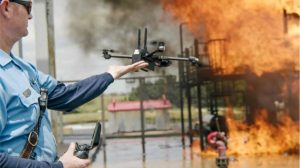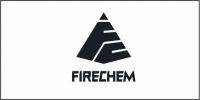 Firefighting drones are revolutionizing how fire departments approach emergency response, enabling enhanced situational awareness, precision, and safety in dangerous environments. These specialized drones, equipped with high-resolution cameras, thermal imaging sensors, and occasionally water or fire retardant delivery systems, provide fire departments with critical tools to monitor, assess, and tackle fires more effectively than traditional methods alone. Here’s an in-depth look at how firefighting drones support fire departments in their mission to protect lives and property.
Firefighting drones are revolutionizing how fire departments approach emergency response, enabling enhanced situational awareness, precision, and safety in dangerous environments. These specialized drones, equipped with high-resolution cameras, thermal imaging sensors, and occasionally water or fire retardant delivery systems, provide fire departments with critical tools to monitor, assess, and tackle fires more effectively than traditional methods alone. Here’s an in-depth look at how firefighting drones support fire departments in their mission to protect lives and property.
- Enhanced Situational Awareness and Rapid Assessment
Drones offer real-time aerial views of active fires, which can be invaluable for fire departments. Equipped with high-definition and thermal cameras, drones provide comprehensive overviews of fire scenes from various angles and altitudes. This bird’s-eye view allows firefighters to quickly assess fire spread, intensity, and potential hazards, such as gas leaks, collapsed structures, or trapped individuals. Instead of relying solely on ground assessments, incident commanders can access accurate, up-to-date data on fire behavior, improving decision-making and response strategy.
- Thermal Imaging for Finding Hotspots and Victims
Thermal imaging sensors are crucial for identifying hotspots in fires, where residual heat can reignite flames even after initial containment. By detecting temperature variations, drones with thermal cameras help firefighters pinpoint areas that require further cooling and extinguishment, reducing the risk of flare-ups. Additionally, thermal imaging assists in locating victims in smoky or low-visibility areas, allowing rescuers to prioritize rescue operations and allocate resources where they’re needed most.
- Support for Large-Scale and Hard-to-Reach Fires
 For large-scale incidents like wildfires, industrial fires, or high-rise building fires, drones extend the reach of fire departments to areas that are otherwise challenging to access. Unlike ground teams and ladder trucks, drones can quickly maneuver over treacherous terrain or within confined urban spaces to assess fire spread and the surrounding landscape. They enable fire departments to coordinate with ground teams by mapping out safe access routes, evacuation zones, and containment areas. In rural or forested areas where large wildfires can rapidly spread, drones provide critical surveillance that guides containment efforts. They also help fire departments monitor the effectiveness of firebreaks and evacuation measures, saving time and potentially lives.
For large-scale incidents like wildfires, industrial fires, or high-rise building fires, drones extend the reach of fire departments to areas that are otherwise challenging to access. Unlike ground teams and ladder trucks, drones can quickly maneuver over treacherous terrain or within confined urban spaces to assess fire spread and the surrounding landscape. They enable fire departments to coordinate with ground teams by mapping out safe access routes, evacuation zones, and containment areas. In rural or forested areas where large wildfires can rapidly spread, drones provide critical surveillance that guides containment efforts. They also help fire departments monitor the effectiveness of firebreaks and evacuation measures, saving time and potentially lives.
- Real-Time Data Collection and Incident Management
Firefighting drones are instrumental in collecting real-time data that can be relayed to command centers and decision-makers instantly. This data, including video feeds, temperature readings, and structural integrity assessments, enables fire departments to make informed decisions about firefighting tactics. Data from drones also aids in assessing risks to nearby structures and ecosystems, ensuring resources are directed to areas where they can be most effective. With a better understanding of fire dynamics, departments can adjust strategies dynamically, optimizing resource use and response speed.
- Aerial Delivery of Water and Fire Retardant
Some firefighting drones are equipped with systems to deliver small amounts of water, fire retardant, or even fire suppressant grenades to specific areas. While they do not replace larger aerial firefighting vehicles like helicopters or tanker planes, drones are effective for targeted suppressant drops in hard-to-reach areas, such as building rooftops or confined urban spaces. This precise delivery minimizes the spread of fire while reducing water wastage, which is especially useful in urban and indoor environments where flooding could cause additional damage.
- Increased Safety for Firefighters
Drones mitigate the risks firefighters face in hazardous conditions by reducing the need for close-range inspection and manual reconnaissance in dangerous areas. By identifying structural risks, fire hotspots, and potential hazards from a distance, drones enable fire departments to make safety-focused decisions, minimizing exposure to smoke, heat, and toxic gases. This additional layer of safety is especially valuable in scenarios where collapsing buildings, volatile materials, or chemical hazards threaten human responders.
- Post-Incident Analysis and Training
Data collected by drones during firefighting incidents can be archived for post-incident analysis, helping fire departments evaluate response strategies and learn from each operation. By reviewing aerial footage, departments can identify areas for improvement, refine response protocols, and develop more effective training programs. This archived data also aids in investigating the cause and origin of fires, supporting the work of fire marshals and forensic teams.
- Cost-Efficiency in Operations
Investing in drones can provide long-term cost savings for fire departments. Drones are generally less expensive to operate than helicopters or other heavy equipment and require fewer personnel for deployment. By enhancing efficiency, drones reduce the need for extensive personnel and equipment resources, lowering overall operational costs while improving the effectiveness of firefighting efforts.
Firefighting drones are invaluable assets for modern fire departments, enabling safer, faster, and more precise emergency responses. Through enhanced situational awareness, real-time data, and support for both fire containment and rescue operations, drones are helping departments address fires more proactively and with greater resilience. As drone technology continues to advance, their capabilities in fire response will only improve, making them a critical tool in firefighting’s evolving landscape.























































